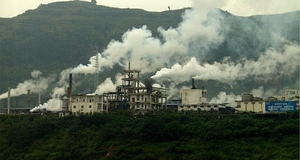Featured Article:Water Pollution Control Policy: Addressing Non-Point Source Pollution2. Salinity TradingSalt pollution in freshwater systems affects the suitability of water for many purposes, such as irrigation or drinking water supply. It can also have significant environmental effects on relatively sensitive ecosystems that rely on salty water, such as in estuaries. Salt pollution usually originates in the mining industry or the energy sector, where cooling by water evaporation leaves saline residues. Salt pollution can also occur naturally as a result of erosion or natural dissolution of salt deposits (Kraemer et al. 2004). The most prominent examples of salinity trading come from Australia, with the inter-state trading case in the Murray-Darling Basin, and the more market-oriented approach in the Hunter River in the State of New South Wales (Kraemer et al. 2004). In both cases, the concern is for reducing and “managing” salt pollution to reduce harm. 2.1 Inter-State Salinity Trading Case: Murray-Darling Basin (Australia)One of the first EI-based approaches to the management of NPS water pollution is the salinity credit and debit program operated by the Murray-Darling Basin Commission. Interstate salinity trading came into force in 1992 as part of the Murray-Darling Basin Salinity and Drainage Strategy, administered by the Murray-Darling Basin Commission, on behalf of the States of New South Wales, Victoria and South Australia. The salt pollution rights are not freely traded by industries or individuals, but are exchanged between the governments of the participating states. Although credits are tradable between the States, they are generally applied within each State to offset debits from drainage entering the river system (James, 1997). The Salinity and Drainage Strategy has been successful in achieving a net reduction of 57 EC (Electrical Conductivity) units in the lower river Murray (Kraemer et al. 2004). 2.2 Salt Pollution Trading Case: Hunter River (Australia)The Hunter River Salinity Trading Scheme is Australia's first active emissions trading scheme, put in operation as a pilot in 1995 by the Environmental Protection Agency of New South Wales (NSW EPA), and has proved to be quite successful (NSW EPA, 2001a). It was established to resolve a longstanding and frequently bitter dispute over the impacts of saline discharges to the Hunter River (Kraemer et al. 2004). Whilst this scheme only operates among point-source emitters, it does show that EI-based instrument approaches can be operated in a manner that provides incentives for people to take account of ambient water qualityEach discharger is allowed to discharge a specified percentage of the total allowable salt load, which is calculated in relation to conductivity levels (Kraemer et al. 2004). The scheme was developed from the existing salt licensing regime and was initially limited to coal mines and the power generation industry of Pacific Power. Trading has allowed major industries such as coal mining and power generation, to discharge saline water on a managed basis. It has also reduced significant costs of water storage or treatment that would otherwise have been incurred by those industries under the previous discharge management system, which included a traditional licensing strategy requiring industries to minimize discharges and discharge a small volume of saline water to the river at all times (Kraemer et al. 2004). A major advantage of the scheme is an extensive monitoring network, which monitors each authorized point of discharge (NSW EPA, 2001b). 3. Trading of Nutrient Pollution RightsNutrients (i.e. nitrogen and phosphorous) are not in themselves dangerous to water or water-based ecosystems. In fact, they are the necessary components of plant life, which is why they are applied as fertilizers to enhance plant growth. They also appear in domestic sewage in significant concentrations and loads. However, in water bodies, they stimulate plant (algal) growth, which consumes oxygen and can thus lead to fish kills (Kraemer et al. 2004). In the following sections, examples are presented from the US including the case of Lake Dillon and the case of the Cherry Creek Basin in Colorado (both involving point to nonpoint source trading). 3.1 Lake Dillon, Colorado (USA)Lake Dillon of Summit County in Colorado has been under significant pressure from phosphorus discharges. Four municipal treatment plants, sixteen small treatment plants, one industrial plant and numerous non-point sources discharge waste into the reservoir. Runoff from towns and ski areas is the main non-point source of phosphorus, along with inadequately managed septic systems (EPA, 1996b). This situation caused a coalition of concerned stakeholders to form the Phosphorus Club. The Phosphorus Club devised an innovative strategy called the Dillon “bubble,” thereby establishing the first trading program in the US (Apogee Research, Inc., 1992). After annual discharge rights of phosphorus load were allocated for every point discharger, trade between point and non-point sources of phosphorus around Lake Dillon has been allowed since 1984. The operating efficiencies of existing municipal tertiary treatment facilities was upgraded and achieved the highest phosphorous removal capabilities in the nation so that by 1990 they only contributed 2% of the total reservoir phosphorous loading (Apogee Research, Inc., 1992). Due to the uncertainty related to the control of non-point source credits for non-point pollutant reductions, they were only traded for point loads at a 2:1 point/nonpoint source trading ratio. Economically, such a trade can make sense for the discharger: the MC for removal of one pound of phosphorus from a wastewater treatment plant is estimated at US$860, while the average cost of non-point source control is US$119 (Carlin, 1992). Thereby, municipal facilities are allowed to obtain phosphorous reduction credits by funding controls to reduce phosphorous loadings from existing urban non-point sources. Until 1988, the basin management authority approved no trading, since critical loads were not exceeded (Carlin, 1992). Until the end of 1996, a few trades had taken place between point and non-point sources. The Lake Dillon phosphorus-trading program has refocused at maintaining equitable non-point to non-point source trading and enforcement. New non-point sources must offset all of their discharges by using a trading ratio of 1:1 with existing non-point sources. The co-operative management approach that grew out of developing the option of this trading program is considered (by a number of stakeholders) to be the reason why Lake Dillon has succeeded in maintaining high water quality (Kraemer et al. 2004). 3.2 Cherry Creek, Colorado (USA)The Cherry Creek reservoir near Denver is an important recreation area and water supply source. A total phosphorus standard was developed in 1984 for the reservoir, as well as a Total Maximum Daily Load (TMDL) (EPA, 1996b) to prevent eutrophication and to maintain water quality standards established by the Colorado Water Quality Commission. The Cherry Creek Trading program allows certain point source polluters to earn phosphorus reduction credits through the control of non-point source phosphorus discharges (Carlin, 1992). The TMDL requires urban non-point sources to reduce phosphorus loads by implementing best management practices (BMP). BMP is a type of water pollution control that is considered the most effective and practical in preventing or minimizing pollution. However, non-point sources, which account for approximately 80% of the basin's phosphorus load, have to reduce their loading by 50% on their own, and only reductions beyond these required non-point reductions can qualify for trading (Great Lakes Trading Network, 2001). Development and credit use are required to be consistent with a basin plan established by the Cherry Creek Basin Water Quality Authority, which was established by the state legislature. The Cherry Creek trading program is being revised to reflect baseline allocations under an updated TMDL (Great Lakes Trading Network, 2001). However, to date, there has been no need to trade at Cherry Creek since phosphorus effluent still remains below the allowed limits. Generally, from the examples of tradable water pollution rights presented above, trading has been applied effectively only to pollution covered by a single chemical or (in the case of electrical conductivity) a single physical parameter. This does not mean that only pollution by identical substances is traded, as the parameters used often refer to classes of substances, such as soluble salts or substances oxidized by bio-chemical processes (Kraemer et al. 2004). However, in the case of nutrient pollution, single elements or substances are the objects of trading (e.g. phosphorus loads). Furthermore, regarding the nutrient trading systems, the experience has been most successful within the conceptual framework of a bubble over point sources. In this context, given that nutrient abatement is largely dependent on up-front investments in treatment systems, trading becomes a tool for allocating and optimizing investment (Kraemer et al. 2004). The system of tradable nutrient pollution permits is underpinned by strong (and pre-existing) regulatory regimes, which provide a framework, including sanctions on individuals for overall failures in pollution abatement (Kraemer et al. 2004). 4. Phosphorous Trading in the South Nation River Watershed, OntarioIn South Nation Watershed, Ontario a point to non-point trading program already exists and other Canadian provinces such as Alberta and Saskatchewan (The South Saskatchewan Water Management Plan) have adopted these kinds of trading programs. According to O’Grady (2008), concentrations of phosphorus in the South Nation River basin of eastern Ontario are well in excess of provincial guidelines. It is noted that NPS are estimated to contribute 90% of the phosphorous load2. The Ontario Ministry of Environment (MOE) ceased issuing new permits for point source phosphorus discharge in the basin in 1998. MOE also designed an offset scheme, which enables new developments to discharge phosphorus provided that it is offset by mitigation activities elsewhere in the basin. This offset scheme is an attempt to reduce the costs that arose due to the permit cap. So far, municipalities have paid upwards of $500,000 for phosphorus offsets, in addition to reduced costs for new dischargers. Most importantly the scheme has been financially beneficial for local farmers3.Continued on Next Page » Suggested Reading from Inquiries Journal
Inquiries Journal provides undergraduate and graduate students around the world a platform for the wide dissemination of academic work over a range of core disciplines. Representing the work of students from hundreds of institutions around the globe, Inquiries Journal's large database of academic articles is completely free. Learn more | Blog | Submit Latest in Economics |














